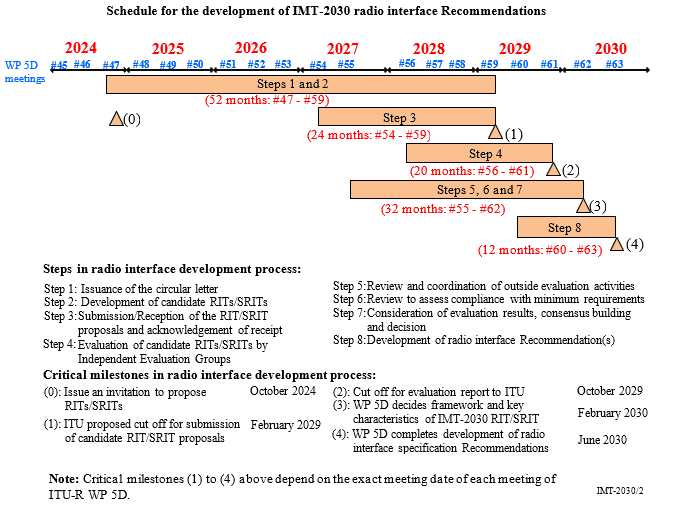ITU-R WP 5D Timeline for submission, evaluation process & consensus building for IMT-2030 (6G) RITs/SRITs
The ITU-R WP 5D schedule described below applies to the first invitation for IMT 2030 candidate RITs [1] or SRITs [2]
[1] RIT =Radio Interface Technology [2] SRITs =Set of RITs. That terminology was used for IMT 2020 and the IMT 2150 recommendation
Submission of proposals may begin at 54th meeting of Working Party (WP) 5D, currently planned for February 2027. The final deadline for submissions is 1600 hours UTC, 12 calendar days prior to the start of the 59th meeting of WP 5D in February 2029.
The evaluation of the proposed RITs/SRITs by the independent evaluation groups and the consensus-building process will be performed throughout this time period and thereafter. Subsequent calendar schedules will be decided according to the submissions of proposals.
References:
https://www.itu.int/dms_pub/itu-r/oth/0a/06/R0A060000C80001PDFE.pdf
https://www.itu.int/rec/R-REC-M.2150/en
ITU-R WP5D IMT 2030 Submission & Evaluation Guidelines vs 6G specs in 3GPP Release 20 & 21
Highlights of 3GPP Stage 1 Workshop on IMT 2030 (6G) Use Cases
ITU-R WP 5D reports on: IMT-2030 (“6G”) Minimum Technology Performance Requirements; Evaluation Criteria & Methodology
ITU-R: IMT-2030 (6G) Backgrounder and Envisioned Capabilities
Verizon’s 6G Innovation Forum joins a crowded list of 6G efforts that may conflict with 3GPP and ITU-R IMT-2030 work
Ericsson and e& (UAE) sign MoU for 6G collaboration vs ITU-R IMT-2030 framework
ITU-R WP5D invites IMT-2030 RIT/SRIT contributions
NGMN issues ITU-R framework for IMT-2030 vs ITU-R WP5D Timeline for RIT/SRIT Standardization
IMT-2030 Technical Performance Requirements (TPR) from ITU-R WP5D
Should Peak Data Rates be specified for 5G (IMT 2020) and 6G (IMT 2030) networks?




From Preliminary New ITU-R Draft Report: Minimum requirements related to technical performance
for IMT-2030 radio interface(s)
IMT-2030 is expected to provide enhanced capabilities as well as new capabilities compared with those described in Recommendation ITU-R M.2083. IMT-2030 is also expected to be built on overarching aspects which act as design principles commonly applicable to all usage scenarios. In addition, IMT-2030 can be considered from multiple perspectives, including users, manufacturers, application developers, network operators, verticals, and service and content providers. Therefore, it is recognized that technologies for IMT-2030 can be applied in a variety of deployment scenarios and can support a range of environments, service capabilities, and technology options.
The intent of the key minimum technical performance requirements for IMT 2030 is to ensure that IMT-2030 RIT/SRIT technologies can fulfill the objectives of IMT 2030 and to set a specific level of performance that each proposed RIT/SRIT needs to achieve to be considered by ITU-R for IMT-2030.
Requirements are to be evaluated according to the criteria defined in Report ITU-R M.[IMT 2030.EVAL] and Report ITU-R M.[IMT-2030.SUBMISSION] for the development of IMT-2030.
Recommendation ITU-R M.2160 defines fifteen key “Capabilities of IMT-2030”, which form a basis for the technical performance requirements.
The distinguishing design principles of IMT 2030 are including, but are not limited to: sustainability, security and resilience, connecting the unconnected for providing universal and affordable access to all users independent of the location, and ubiquitous intelligence for improving overall system performance. [These overarching design principles and relevant IMT-2030 capabilities that are not captured as specific technical performance requirements in this report, may instead be captured in Report ITU-R M.[IMT 2030.SUBMISSION]].
…………………………………………………………………………………………………………………..
[Theoretical] Peak data rate:
Peak data rate is the maximum achievable data rate under ideal conditions by theoretical analysis, which is the received data bits assuming error-free conditions assignable to a single mobile station, when all assignable radio resources for the corresponding link direction are utilized (i.e. excluding radio resources that are used for physical layer synchronization, reference signals or pilots, guard bands and guard times).
Peak data rate is defined for a single mobile station. In a single band, it is related to the peak Spectral efficiency in that band. Let W denote the channel bandwidth and SEp denote the peak Spectral efficiency in that band. Then the peak data rate Rp is given by: Rp = W × SEp